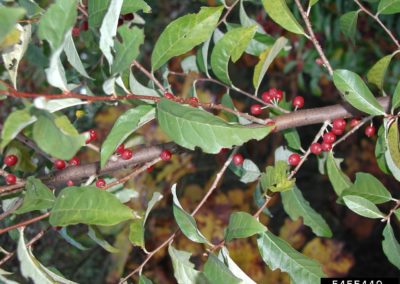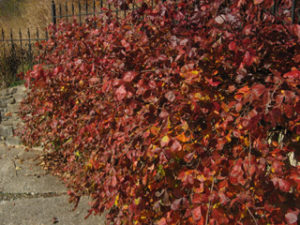Autumn Olive (Elaeagnus umbellata)
Invasive Management Profile
Autumn Olive is an invasive species in Indiana that creates dense shade hindering the growth of native plants in the area. Autumn Olive produces 200,000 seeds each year. Many birds are attracted to the seeds which allows them to spread easily.
Identification
Autumn Olive has unique flowers and berries which make for easy identification. The Autumn Olive is a shrub reaching between 3 to 20 feet in height. The leaves of the Autumn Olive are elliptical in shape, wavy, and are approximately 2 inches in length. They can be easily identified by the silvery scales found on the underside of the leaf. Its flowers bloom from February to June in clumps of 5 to 10 flowers. The flowers are cream to pale yellow in color. The Autumn Olive may also contain thorns near the flowers. Its red berries appear in August to November in large bunches.
Tools & Supplies Needed
- Handsaw and/or chainsaw
- Gardening scissors or loppers
- Sharp shovel
- Protective eyewear, gloves, and clothing
- Tarp, plastic or paper bag for disposal
- Herbicide
Removal Methods
If Autumn Olive is full grown, a professional tree removal service might be the best option. For more information on tree removal services in your area click here.
The best way to remove individual Autumn Olive shrubs is to cut the plant at ground level in the late summer.
STEP 1 : Identify plant using our identification tips and photos as well as the time of year and growth stage.
STEP 2 : Wear protective eyewear, gloves, and clothing.
STEP 3 : Using a lopper cut the branches as close to the ground as possible leaving a stump.
STEP 4 : Once cut, apply undiluted herbicide to the stump. Or, if possible, dig up the root system using a sharp shovel. If you choose to use herbicide click here for more safety information.
STEP 5 : For removal of the root system, start digging 3 feet away from the base of the stump.
STEP 6 : Once you can see the majority of the rootball, slide your shovel under it, loosen it, and pry it up away from the ground.
STEP 7 : Once the rootball is free, place it and all clippings on a tarp to stop the spread of seeds.
STEP 1 : Identify plant using our identification tips and photos as well as the time of year and growth stage.
STEP 2 : Wear protective eyewear, gloves and clothing.
STEP 3 : After reading all safety labels, use a chainsaw to cut the tree 5 inches from the ground.
STEP 4 : Treat with herbicide or proceed to step 5 in Cut Stump Method.
STEP 5 : Make sure to collect and bag any fallen fruit from the Autumn Olive to prevent seed dispersal.
Disposal
For disposal of Autumn Olive, package the plant waste in a large plastic or paper bag for landfill. Small sapling shrubs can be disposed of in the trash and will be picked up through regular trash collection. Large trees can be picked up through the city’s heavy trash collection provided they are tied into bundles no larger than 3 feet by 3 feet. Heavy trash collection guidelines and monthly pick-up days for your address can be found here.
Beyond trash collection services, you may need to either hire someone to come and remove the yard waste generated from your Autumn Olive removal or haul the waste away yourself. Many landscaping companies will accept yard waste for a small cost. They then process this material into mulch or compost. Click here to learn more about tree removal services in your area.
Native Alternative Species
To learn more about natives and how to landscape with them click here.
Silky Dogwood (Cornus amomum)
|
Growth Type: Deciduous shrub
Height: 6 to 12 feet
Spread: 6 to 12 feet
Bloom Time & Description: May to June; showy yellowish white flower
Fruit: Showy
Light exposure: Full sun to part shade
Attracts: Birds
Tolerate: Deer, Erosion, Wet Soil, Black Walnut
|
Need Photo |
Fragrant Sumac (Rhus aromatica)
|
Growth Type: Deciduous shrub
Height: 2 to 6 feet
Spread: 6 to 10 feet
Bloom Time & Description: April; showy yellow flower
Fruit: Showy
Light exposure: Full sun to part shade
Attracts: Birds, Butterflies
Tolerate: Rabbit, Drought, Erosion, Clay Soil, Dry Soil, Shallow-Rocky Soil, Black Walnut
|
Photo Courtesy of INPAWS |




